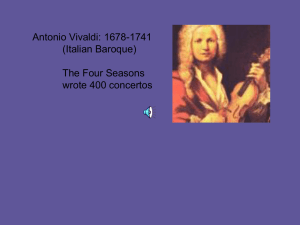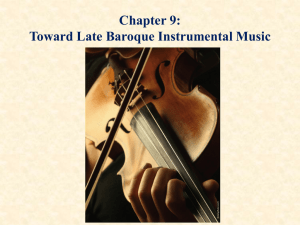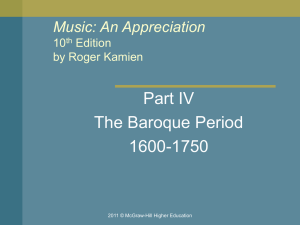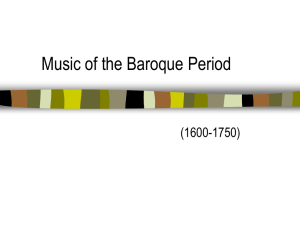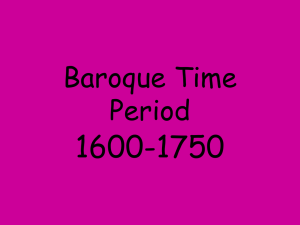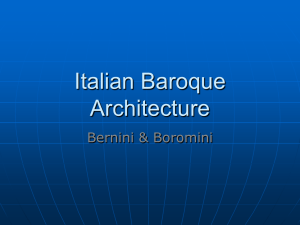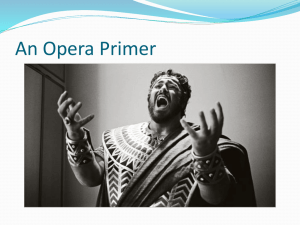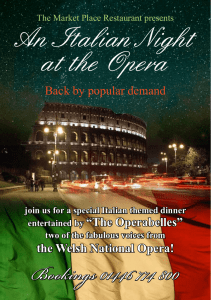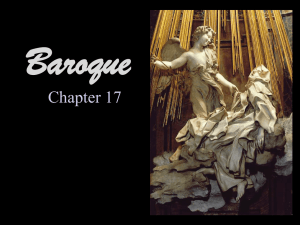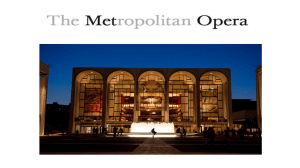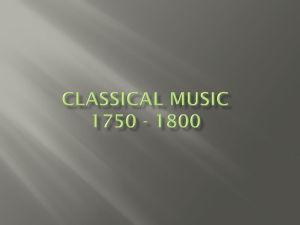Baroque Period: Music History Presentation (1600-1750)
advertisement
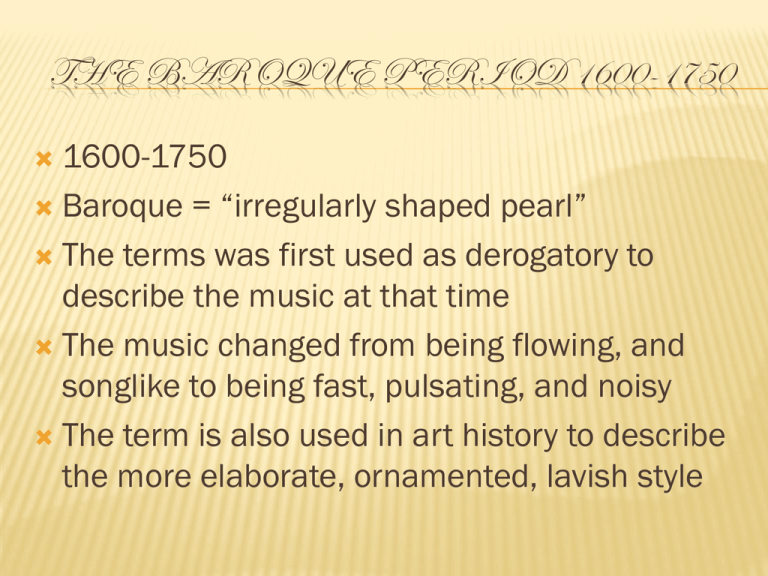
THE BAROQUE PERIOD 1600-1750 1600-1750 Baroque = “irregularly shaped pearl” The terms was first used as derogatory to describe the music at that time The music changed from being flowing, and songlike to being fast, pulsating, and noisy The term is also used in art history to describe the more elaborate, ornamented, lavish style THE BAROQUE PERIOD 1600-1750 Age of Exploration, Colonization, and Scientific Discovery Isaac Newton – 1642-1727 Rene Descartes – 1596-1650 Technologies Telescope, microscope, thermometer, syringe, slide rule, barometer, wind gauge, pressure cooker, tuning fork, and steam engine THE BAROQUE PERIOD 1600-1750 THE BAROQUE PERIOD 1600-1750 Two Practices, Three Styles First Practice (Old Style) The music dominates the text Second The Three Practice (New Style) text dominates the music Styles Ecclesiasticus (church) Cubicularis (chamber) Scenicus seu theatralis (scenic or theater) THE BAROQUE PERIOD 1600-1750 After taking the time to read and explore the writing of the Greeks, composers of the Baroque period being writing for the affections Affections – rationalized emotional states or passions (anger, fear, happiness, love) If a listener was unaware of the affections that a composer was using in a song, that person would consider the song grotesque THE BAROQUE PERIOD 1600-1750 Music Theory Key Tonality The evolution of the major and minor scales becomes defined and used as the standard in Western music Rhythm The pulse of music remained the same as that of the style of the Renaissance Definitions of tempos begin to appear in musical pieces – allegro, andante, presto, moderato, etc. Notation As the printing of music became more refined, bar lines and measures were created to help organize music THE BAROQUE PERIOD 1600-1750 Time signatures begin to be used define the number of beats in each measure Clef signs begin to be used to define the range of the notes that are used on a staff – also helps determine the instrument that was to be played F Clef – Modern day Bass Clef C Clef – Modern day moveable Clef G Clef – Modern day Treble Clef THE BAROQUE PERIOD 1600-1750 Vocal music and instrumental music continue to be written together and separate Instrumental music begins to gain ground as an independent musical form Composers and musicians begin to write and perform instrumental music – compositions and performances begin to accumulate and gain a heightened status THE BAROQUE PERIOD 1600-1750 Monody Italian solo song that is accompanied Intermedio Musical interlude between acts of plays Opera Italian drama presented musically Combined scenery, costumes, literature, acting, with vocal and instrumental music Teatro – theater, performance venue for operas. Begin popping up in major cities in Italy THE BAROQUE PERIOD 1600-1750 Libretto A book of text that is set to music Important in creating operas Oratorio Similar to an opera except without stage action, scenery, or costumes Has a narrator Mainly deals with religious subjects, in Latin Oratorio Volgare Oratorio in the native language THE BAROQUE PERIOD 1600-1750 Dafne – 1598 The first opera ever written and performed In Florence Jacopo Corsi (1561-1602) Composer Ottavio Rinuccini (1562-1621) Librettist Moral of story – to demonstrate the dangers that await those who scorn love’s power Story – Dafne, a nymph, complains about a monster hunting their sheep, Apollo slays the monster, makes fun of Cupid, Cupid shoots Apollo with arrow and falls in love with Dafne, Dafne wants to escape so she prays to the gods who turn her into a laurel tree, Apollo grieves for Dafne, declares his love for her in front of the tree, and promises to wear laurel leaves in his hair. THE BAROQUE PERIOD 1600-1750 Claudio Monteverdi 1567-1643 Italian composer Composed 3 operas, a ballet, 12 volumes of 250 madrigals, 5 volumes of sacred music, and 20 sacred pieces Famous for integrating the old style and new style of music together – creating a balance Opera flourishes from Florence, to Mantua, to Rome, to Venice, to Naples, then to Europe THE BAROQUE PERIOD 1600-1750 Alessandro Scarlatti 1660-1725 Composed operas, oratorios, intermedios, and even comedic works Shifted center of music to Naples Used the new “Italian Overture” in operas Italian Overture – orchestral piece played at the beginning of an opera, with no musical relation to the opera, three sections, tempo was fastslow-fast THE BAROQUE PERIOD 1600-1750 Jean-Baptiste Lully 1632-1687 French composer of Ballets and Operas Adopted the Italian Opera and created the French Opera Used the “French Overture” in operas French Overture – orchestral piece played at the beginning of an opera, with no musical relation to the opera, two sections, tempo was slow-fast THE BAROQUE PERIOD 1600-1750 England Masque – an aristocratic entertainment blending the art of poetry, dance, song, and instrumental music into a dramatic form with elaborate staging Henry Purcell 1659-1695 Greatest English composer, composed vocal and instrumental secular and sacred music Composed the first English opera “Dido and Aeneas” in 1689. This opera started with a French Overture THE BAROQUE PERIOD 1600-1750 Germanic Lands German opera has a slow start, French and Italian operas are popular instead Singspeil – German opera Reinhard Keiser 1674-1739 The most important composer of German operas Russia Italian operas did not reach Russia until 1730 due to their isolation THE BAROQUE PERIOD 1600-1750 Spain Pedro Calderon de la Barca 1600-1681 Credited with inventing the Spanish opera Zarzuela Spanish opera – Spanish dramatic form with singing, dancing, and spoken language Spanish First America opera ever written in America was in Peru in 1658, to honor King Philip V on his 18th birthday and first year of his reign THE BAROQUE PERIOD 1600-1750 Instrumental Music Four Principal Styles Dance music Improvisatory Variations Imitative counterpoint Dance Music music for dancing Allemande – duple meter, moderate tempo Courante – French dance, triple meter, moderate tempo Saraband – triple meter, slow tempo Gigue – duple or triple meter, fast tempo THE BAROQUE PERIOD 1600-1750 Suite Grouping of dance pieces compiled into a single, complete work Improvisatory improvised, made up without preparation Fantasia – composition evoking free style improvisation Toccata – sectional composition for a keyboard Prelude – self contained movement in an improvisatory style THE BAROQUE PERIOD 1600-1750 Variations a melody that was repeated throughout a song, but the supporting parts of the melody were changed Imitative Counterpoint one melody starts at the beginning of a song and then the same melody starts at a different part in the song Example: canons and rounds THE BAROQUE PERIOD 1600-1750 Sonata Piece Cantata Piece of instrumental music of vocal music Sonata da chiesa Church sonata – instrumental church music Sonata da camera Court sonata – instrumental court music THE BAROQUE PERIOD 1600-1750 Concerto Vocal Concertino Small ensemble of instruments Strophic Same ensemble of instruments Concerto Grosso Large music accompanied by instrumentalists music for each stanza of text Through-composed New music for each stanza of text THE BAROQUE PERIOD 1600-1750 Arcangelo Corelli 1653-1713 Italian violinist and composer Famous for composing music mostly for violin THE BAROQUE PERIOD 1600-1750 Antonio Vivaldi 1678-1741 Italian composer, violinist Composed 49 operas, 90 sonatas, 500 concertos Expanded the concerto style of music, used fastslow-fast movements Well known for “The Four Seasons” and his “Gloria’s” THE BAROQUE PERIOD 1600-1750 Jean-Philippe Rameau 1683-1764 French musician, composer, and theorist Attempted to compose operas – not very successful Composed instrumental music, secular and sacred Studied music theory as a science – believed that all music came from harmony and studied its effects in nature – vibrations (compared to modern day sound waves) THE BAROQUE PERIOD 1600-1750 Johann Sebastian Bach 1685-1750 German composer and great keyboard performer Musical genius in composition of keyboard music and performance Composed mainly for instruments, no operas Baroque period ends at the death of Bach because he begins to incorporate “Classical” features in his musical style THE BAROQUE PERIOD 1600-1750 George Frideric Handel 1685-1759 German composer, but became British citizen Composed operas, oratorios, instrumental music Best known for the “Messiah” and “Water Music” Invented the Organ Concerto
